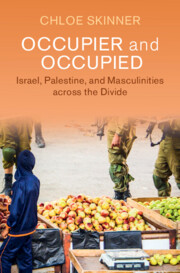Refine search
Actions for selected content:
201 results
6 - Trumpism and the Future of Impunity
-
- Book:
- Killing Machines
- Published online:
- 23 October 2025
- Print publication:
- 06 November 2025, pp 200-259
-
- Chapter
-
- You have access
- Open access
- HTML
- Export citation
Laboring Liberation: The Jerusalem Electricity Company Workers’ Strike of 1979
-
- Journal:
- International Labor and Working-Class History , First View
- Published online by Cambridge University Press:
- 16 October 2025, pp. 1-7
-
- Article
-
- You have access
- Open access
- HTML
- Export citation
Social Reproduction as Survival and Insurgency in Gaza
-
- Journal:
- International Labor and Working-Class History , First View
- Published online by Cambridge University Press:
- 08 October 2025, pp. 1-5
-
- Article
-
- You have access
- Open access
- HTML
- Export citation
Chapter 2 - The Crusades
- from Part I - Contexts
-
-
- Book:
- The Cambridge Guide to Global Medieval Travel Writing
- Published online:
- 03 October 2025
- Print publication:
- 02 October 2025, pp 40-56
-
- Chapter
- Export citation
Palestine Magazines and Co-Created Solidarity in Scandinavia
- Part of
-
- Journal:
- Public Humanities / Volume 1 / 2025
- Published online by Cambridge University Press:
- 29 September 2025, e140
-
- Article
-
- You have access
- Open access
- HTML
- Export citation
6 - Palestinian Anticolonial National Liberation in the Present
- from Part II - Schools of Thought
-
-
- Book:
- Anticolonialism and Social Thought
- Published online:
- 16 September 2025
- Print publication:
- 25 September 2025, pp 139-161
-
- Chapter
- Export citation

Palestinian Doctors
- Medical Practice and the Transformation of Palestine, 1900–1948
-
- Published online:
- 12 September 2025
- Print publication:
- 02 October 2025
Challenging punishment as the justice norm in the face of ongoing atrocities
-
- Journal:
- Leiden Journal of International Law , First View
- Published online by Cambridge University Press:
- 08 September 2025, pp. 1-28
-
- Article
-
- You have access
- Open access
- HTML
- Export citation
How the Past Became a Weapon of Genocide in Palestine
- Part of
-
- Journal:
- Public Humanities / Volume 1 / 2025
- Published online by Cambridge University Press:
- 04 September 2025, e134
-
- Article
-
- You have access
- Open access
- HTML
- Export citation
Affective sovereignty: A decolonising politics of emotion in Palestine
-
- Journal:
- Review of International Studies , First View
- Published online by Cambridge University Press:
- 15 August 2025, pp. 1-23
-
- Article
-
- You have access
- Open access
- HTML
- Export citation
Chapter 5 - International legal personality
-
- Book:
- International Law
- Published online:
- 26 July 2025
- Print publication:
- 31 July 2025, pp 245-302
-
- Chapter
- Export citation
7 - Jewish Architecture
- from Part I - Architecture and Iconography
-
- Book:
- The Cambridge Encyclopaedia of Late Antique Art and Archaeology
- Published online:
- 04 July 2025
- Print publication:
- 31 July 2025, pp 108-127
-
- Chapter
- Export citation
The Notion of an Illegal Occupation in the ICJ’s Palestine Advisory Opinion
-
- Journal:
- International & Comparative Law Quarterly / Volume 74 / Issue 3 / July 2025
- Published online by Cambridge University Press:
- 08 September 2025, pp. 517-553
- Print publication:
- July 2025
-
- Article
-
- You have access
- Open access
- HTML
- Export citation
Introduction
-
- Book:
- Occupier and Occupied
- Published online:
- 15 June 2025
- Print publication:
- 26 June 2025, pp 1-33
-
- Chapter
- Export citation
Conclusion
-
- Book:
- Occupier and Occupied
- Published online:
- 15 June 2025
- Print publication:
- 26 June 2025, pp 144-151
-
- Chapter
- Export citation
4 - ‘It’s the Way I Empty What Is Inside of Me’: Occupied Masculinities, Emotional Expression, and Rap Music in a Palestinian Refugee Camp
-
- Book:
- Occupier and Occupied
- Published online:
- 15 June 2025
- Print publication:
- 26 June 2025, pp 94-107
-
- Chapter
- Export citation
2 - ‘You Can Do Nothing; He Is a Soldier with Gun, and He Is Controlling You’: The Masculinised Body under Occupation
-
- Book:
- Occupier and Occupied
- Published online:
- 15 June 2025
- Print publication:
- 26 June 2025, pp 56-74
-
- Chapter
- Export citation
6 - At the Nexus of Colonialism, Imperialism, and Imbalanced Patriarchies: Narratives and Expressions of Gender Violence in Occupied Palestine
-
- Book:
- Occupier and Occupied
- Published online:
- 15 June 2025
- Print publication:
- 26 June 2025, pp 127-143
-
- Chapter
- Export citation
Improving the delivery of electroconvulsive therapy in the West Bank, Palestine
-
- Journal:
- BJPsych International , FirstView
- Published online by Cambridge University Press:
- 26 June 2025, pp. 1-4
-
- Article
-
- You have access
- Open access
- HTML
- Export citation

Occupier and Occupied
- Israel, Palestine, and Masculinities across the Divide
-
- Published online:
- 15 June 2025
- Print publication:
- 26 June 2025
